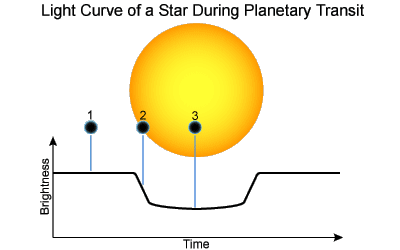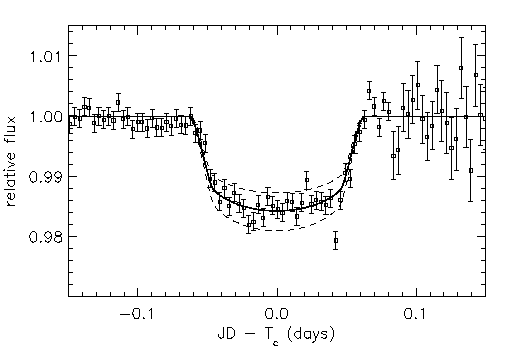
 Download
preprint accepted by Astrophysical Journal Letters, 23 November,
1999 (310Kb PS file or
162Kb PDF file).
Download
preprint accepted by Astrophysical Journal Letters, 23 November,
1999 (310Kb PS file or
162Kb PDF file).
 Download ASCII file of
HD 209458 photometric data.
Download ASCII file of
HD 209458 photometric data.
Planetary Transit Across Star
HD 209458 Detected by STARE Project Astronomers
At the end of August, 1999, STARE Project Astronomers Dr. Tim Brown and
David Charbonneau started observing the star HD 209458 on the advisement of Dr.
David Latham of the
Harvard-Smithsonian Center for Astrophysics. Latham inferred from
his radial-velocity analysis of the motion of the star (refer to
Exoplanet Search Methods for more
information) that a planetary companion was present and possibly orbiting in
an edge-on orientation. When an orbit is aligned this way, the planet will
pass between its star and the Earth (transit) once each orbit, causing a
slight dimming of the star's light as in the figure below (see
STARE Search Method for a more
detailed
explanation). After analyzing data collected by the STARE telescope, such a
dimming was discovered occurring on the nights of September 9th and 16th. The
times of these transits coincided exactly with the expected times predicted
by the radial-velocity analysis. A partial transit in November was observed
by G. Henry (Tennessee State University). Further details on this observation
are available at the
TSU Automated Astronomy Group website.

Figure based on one by Hans Deeg, from
'Transits of Extrasolar Planets'
When the properties of the parent star are known (such as radius, color, and
limb darkening), subsequent analysis of the transit light curve (below) can be
used to determine many properties of the planet not discernible by
radial-velocity measurements alone. In the case of HD 203458, the radius of
the planet is estimated at 1.27 times that of Jupiter (or around 91,000 km).
This measurement, coupled with the mass determined by both the radial velocity
and transit parameters (approximately 63% that of Jupiter, or 1.2 x 10^27 kg),
allows for the calculation of surface gravity (at 9.7 m/s^2, just slightly
lower than Earth's) and density (approximately 0.38 g/cm^3, so low that if
there was an ocean large enough, the planet would float!)

Superposed lightcurves of star HD 209458 showing transits
occurring on 9 and 16 September, 1999
This first planetary transit discovery is very exciting in that it gives
astronomers a wealth of new information about the properties and formation of
other solar systems (such as the make-up of
extra-solar planetary atmospheres).
Please revisit the STARE web page in the future for updates on this and any
other transit discoveries.


Download preprint accepted by Astrophysical Journal Letters, 23 November, 1999 (310Kb PS file or 162Kb PDF file).
Download ASCII file of HD 209458 photometric data.

Download preprint accepted by Astrophysical Journal Letters, 23 November, 1999 (310Kb PS file or 162Kb PDF file).
Download ASCII file of HD 209458 photometric data.
